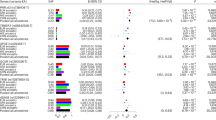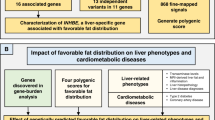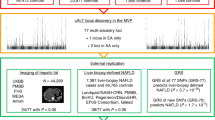Abstract
Nonalcoholic fatty liver disease (NAFLD) is the most common form of liver disease. To elucidate the molecular basis of NAFLD, we performed an exome-wide association study of liver fat content. Three variants were associated with higher liver fat levels at the exome-wide significance level of 3.6 × 10−7: two in PNPLA3, an established locus for NAFLD, and one (encoding p.Glu167Lys) in TM6SF2, a gene of unknown function. The TM6SF2 variant encoding p.Glu167Lys was also associated with higher circulating levels of alanine transaminase, a marker of liver injury, and with lower levels of low-density lipoprotein–cholesterol (LDL-C), triglycerides and alkaline phosphatase in 3 independent populations (n > 80,000). When recombinant protein was expressed in cultured hepatocytes, 50% less Glu167Lys TM6SF2 protein was produced relative to wild-type TM6SF2. Adeno-associated virus–mediated short hairpin RNA knockdown of Tm6sf2 in mice increased liver triglyceride content by threefold and decreased very-low-density lipoprotein (VLDL) secretion by 50%. Taken together, these data indicate that TM6SF2 activity is required for normal VLDL secretion and that impaired TM6SF2 function causally contributes to NAFLD.
This is a preview of subscription content, access via your institution
Access options
Subscribe to this journal
Receive 12 print issues and online access
$209.00 per year
only $17.42 per issue
Buy this article
- Purchase on Springer Link
- Instant access to full article PDF
Prices may be subject to local taxes which are calculated during checkout




Similar content being viewed by others
Accession codes
References
Tiniakos, D.G., Vos, M.B. & Brunt, E.M. Nonalcoholic fatty liver disease: pathology and pathogenesis. Annu. Rev. Pathol. 5, 145–171 (2010).
Browning, J.D. et al. Prevalence of hepatic steatosis in an urban population in the United States: impact of ethnicity. Hepatology 40, 1387–1395 (2004).
McCullough, A.J. The clinical features, diagnosis and natural history of nonalcoholic fatty liver disease. Clin. Liver Dis. 8, 521–533, viii (2004).
Romeo, S. et al. Genetic variation in PNPLA3 confers susceptibility to nonalcoholic fatty liver disease. Nat. Genet. 40, 1461–1465 (2008).
Speliotes, E.K. et al. Genome-wide association analysis identifies variants associated with nonalcoholic fatty liver disease that have distinct effects on metabolic traits. PLoS Genet. 7, e1001324 (2011).
Yuan, X. et al. Population-based genome-wide association studies reveal six loci influencing plasma levels of liver enzymes. Am. J. Hum. Genet. 83, 520–528 (2008).
Chambers, J.C. et al. Genome-wide association study identifies loci influencing concentrations of liver enzymes in plasma. Nat. Genet. 43, 1131–1138 (2011).
Victor, R.G. et al. The Dallas Heart Study: a population-based probability sample for the multidisciplinary study of ethnic differences in cardiovascular health. Am. J. Cardiol. 93, 1473–1480 (2004).
Gorden, A. et al. Genetic variation at NCAN locus is associated with inflammation and fibrosis in non-alcoholic fatty liver disease in morbid obesity. Hum. Hered. 75, 34–43 (2013).
Hernaez, R. et al. Association between variants in or near PNPLA3, GCKR, and PPP1R3B with ultrasound-defined steatosis based on data from the Third National Health and Nutrition Examination Survey. Clin. Gastroenterol. Hepatol. 11, 1183–1190 e2 (2013).
Stender, S., Frikke-Schmidt, R., Nordestgaard, B.G. & Tybjaerg-Hansen, A. Extreme bilirubin levels as a causal risk factor for symptomatic gallstone disease. JAMA Intern. Med. 173, 1222–1228 (2013).
Teslovich, T.M. et al. Biological, clinical and population relevance of 95 loci for blood lipids. Nature 466, 707–713 (2010).
Kathiresan, S. et al. Six new loci associated with blood low-density lipoprotein cholesterol, high-density lipoprotein cholesterol or triglycerides in humans. Nat. Genet. 40, 189–197 (2008).
Kathiresan, S. et al. Common variants at 30 loci contribute to polygenic dyslipidemia. Nat. Genet. 41, 56–65 (2009).
Krogh, A., Larsson, B., von Heijne, G. & Sonnhammer, E.L. Predicting transmembrane protein topology with a hidden Markov model: application to complete genomes. J. Mol. Biol. 305, 567–580 (2001).
Marchler-Bauer, A. et al. CDD: a Conserved Domain Database for the functional annotation of proteins. Nucleic Acids Res. 39, D225–D229 (2011).
Kaliannan, K. et al. Intestinal alkaline phosphatase prevents metabolic syndrome in mice. Proc. Natl. Acad. Sci. USA 110, 7003–7008 (2013).
Friedewald, W.T., Levy, R.I. & Fredrickson, D.S. Estimation of the concentration of low-density lipoprotein cholesterol in plasma, without use of the preparative centrifuge. Clin. Chem. 18, 499–502 (1972).
Szczepaniak, L.S. et al. Measurement of intracellular triglyceride stores by H spectroscopy: validation in vivo. Am. J. Physiol. 276, E977–E989 (1999).
Price, A.L. et al. Principal components analysis corrects for stratification in genome-wide association studies. Nat. Genet. 38, 904–909 (2006).
Folch, J., Lees, M. & Sloane Stanley, G.H. A simple method for the isolation and purification of total lipides from animal tissues. J. Biol. Chem. 226, 497–509 (1957).
Chen, Z. et al. AAV8-mediated long-term expression of human LCAT significantly improves lipid profiles in hCETP;Ldlr+/− mice. J. Cardiovasc. Transl. Res. 4, 801–810 (2011).
Acknowledgements
We thank F. Xu for excellent technical assistance. This work was supported by grants from the US National Institutes of Health (HL20948, 1HL092550 and DK090066) and the National Center for Advancing Translational Sciences (UL1TR001105). T.F.V. acknowledges the contributions of G. Gao (University of Massachusetts) for advice and assistance with AAV vector production.
Author information
Authors and Affiliations
Contributions
The manuscript was prepared by all of the authors. E.S. and H.H.Z. performed the experiments. J.K. and S.S. performed the genetic analysis and association studies. T.F.V., A.T.-H., B.G.N., J.C.C. and H.H.H. provided experimental design and coordination.
Corresponding authors
Ethics declarations
Competing interests
The authors declare no competing financial interests.
Integrated supplementary information
Supplementary Figure 1 Short hairpin RNA–mediated knockdown of Tm6sf2 in mice.
(a) AAV vector alone or AAV expressing an shRNA against mouse Tm6sf2 mRNA were injected into the tail veins of 8-week-old chow-fed C57Bl/6J male mice (n = 5/group). After 2 weeks, the mice were killed and the liver, white adipose tissue (WAT) and small intestine were harvested. Levels of Tm6sf2 mRNA were measured using real-time PCR and normalized to m36B4 levels. The differences in mean expression levels were compared using a two-sample t test. (b) AAV expressing three different shRNAs or AAV vector alone were injected intravenously into 8-week-old chow-fed C57Bl/6J male mice (n = 6/group). All three shRNAs were directed against mouse Tm6sf2, but only shRNA8 knocked down the levels of Tm6sf2 mRNA with high efficiency in cultured cells. Two weeks after the injection, mice were fasted for 4 h, the livers were harvested, and the levels of Tm6sf2 mRNA were measured using real-time PCR. Values were normalized to m36B4 and expressed relative to the mean value of the AAV-only treated mice. Plasma was collected in the same experiment, and triglyceride and cholesterol levels were measured as described in the Online Methods. Differences in mean expression levels were compared using two-sample t tests. Ct, cycle threshold value.
Supplementary information
Supplementary Text and Figures
Supplementary Figure 1 and Supplementary Tables 1–6 (PDF 661 kb)
Source data
Rights and permissions
About this article
Cite this article
Kozlitina, J., Smagris, E., Stender, S. et al. Exome-wide association study identifies a TM6SF2 variant that confers susceptibility to nonalcoholic fatty liver disease. Nat Genet 46, 352–356 (2014). https://doi.org/10.1038/ng.2901
Received:
Accepted:
Published:
Issue Date:
DOI: https://doi.org/10.1038/ng.2901
This article is cited by
-
Parental History of Type 2 Diabetes Mellitus and PNPLA3 Polymorphism Increase the Risk of Severe Stages of Nonalcoholic Fatty Liver Disease
Digestive Diseases and Sciences (2024)
-
Metabolic disorders induced by PNPLA3 and TM6SF2 gene variants affect chronic kidney disease in patients infected with non-genotype 3 hepatitis C virus
Lipids in Health and Disease (2023)
-
Association of non-high-density lipoprotein cholesterol trajectories with the development of non-alcoholic fatty liver disease: an epidemiological and genome-wide association study
Journal of Translational Medicine (2023)
-
The efficacy of L-carnitine in patients with nonalcoholic steatohepatitis and concomitant obesity
Lipids in Health and Disease (2023)
-
Genetic predisposition to nonalcoholic fatty liver disease: insights from ANGPTL8 gene variants in Iranian adults
Lipids in Health and Disease (2023)



